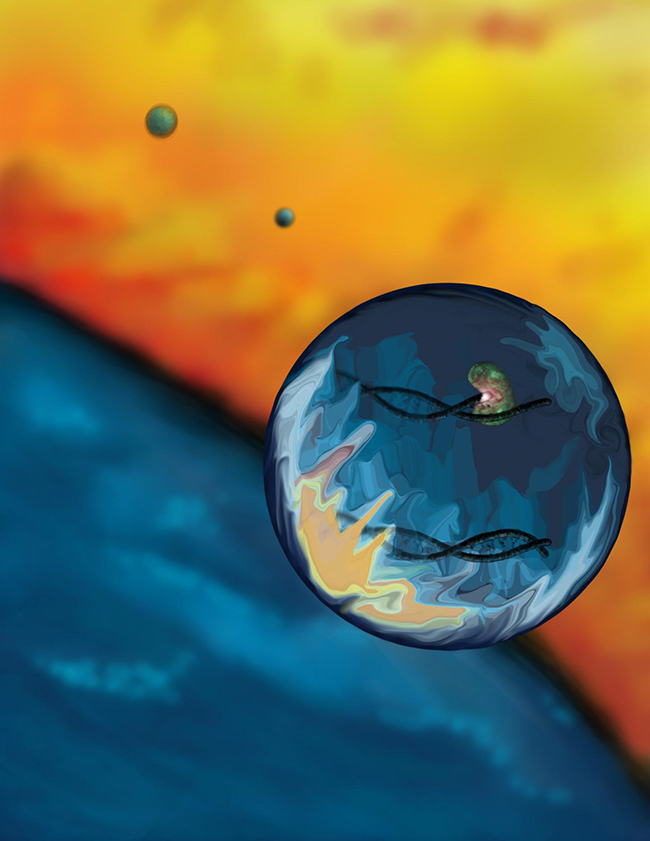![University of Texas at Austin scientists have created a way for RNA to proofread copies of genetic information for the first time. This artist's interpretation of the process shows RNA making DNA copies in a droplet of water. [Jared Ellefson/University of Texas at Austin]](https://genengnews.com/wp-content/uploads/2018/08/118238_web12252461831-1.jpg)
University of Texas at Austin scientists have created a way for RNA to proofread copies of genetic information for the first time. This artist’s interpretation of the process shows RNA making DNA copies in a droplet of water. [Jared Ellefson/University of Texas at Austin]
The creation of cDNA from RNA templates is an integral part of molecular biology that is mediated by reverse transcriptase (RT) enzymes. Unfortunately, these proteins are notoriously error prone, due to their inherent lack of proofreading (3′-5′ exonuclease) activity. The majority of RT enzymes have evolved along ancient evolutionary lines from a single protein family that has been intertwined with retroviral evolution. Now, researchers at The University of Texas at Austin have developed a fix that allows RNA to proofread accurately for the first time. This new RT xenopolymerase (RTX) showed increased fidelity as compared to natural RTs, and the researchers believe the enzyme should streamline and increase the precision of transcriptomics methods.
The investigators initially set out to determine if the lack of proofreading is a historical coincidence or a functional limitation of reverse transcription—to which they they attempted to evolve a high-fidelity, thermostable DNA polymerase that utilized RNA templates efficiently. The enzyme the UT Austin team developed allows, for the first time, for large amounts of RNA information to be copied with near-perfect accuracy.
“We created a new group of enzymes that can read the genetic information inside living cells with unprecedented accuracy,” explained lead study author Jared Ellefson, Ph.D., a postdoctoral fellow at UT Austin's Center for Systems and Synthetic Biology. “Overlooked by evolution, our enzyme can correct errors while copying RNA.”
The findings from this study were published recently in Science in an article entitled “Synthetic Evolutionary Origin of a Proofreading Reverse Transcriptase.”
Reverse transcription is typically associated with retroviruses such as human immunodeficiency virus (HIV). In nature, these viruses' inability to copy DNA accurately may have inadvertently aided in creating variety in species over time, contributing to the complexity of life as we know it.
Since discovering reverse transcription, scientists have employed the technique to understand better genetic information related to inheritable diseases and other aspects of human health. Still, the error-prone nature of existing RNA sequencing has been a problem for scientists.
“With proofreading, our new enzyme increases precision and fidelity of RNA sequencing,” Dr. Ellefson noted. “Without the ability to faithfully read RNA, we cannot accurately determine the inner workings of cells. These errors can lead to misleading data in the research lab and potential misdiagnosis in the clinical lab.”
The UT Austin team engineered the RTX enzyme using directed evolution to train a high-fidelity (proofreading) DNA polymerase to use RNA templates—while still retaining its highly accurate and efficient proofreading function. Accuracy is improved at least threefold, and it could reach levels as high as ten times as accurate. This new enzyme could enhance the methods used to read RNA from cells.
“As we move towards an age of personalized medicine where everyone's transcripts will be read out almost as easily as taking a pulse, the accuracy of the sequence information will become increasingly important,” remarked senior study author Andrew Ellington, Ph.D., professor of molecular biosciences at UT Austin. “The significance of this is that we can now also copy large amounts of RNA information found in modern genomes, in the form of the RNA transcripts that encode almost every aspect of our physiology. This means that diagnoses made based on genomic information are far more likely to be accurate.”


